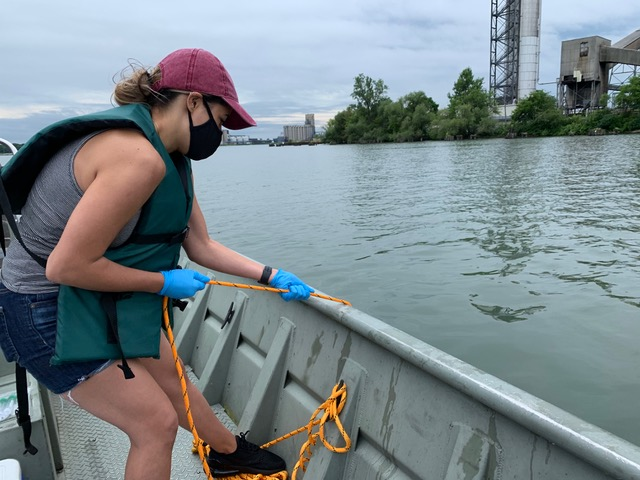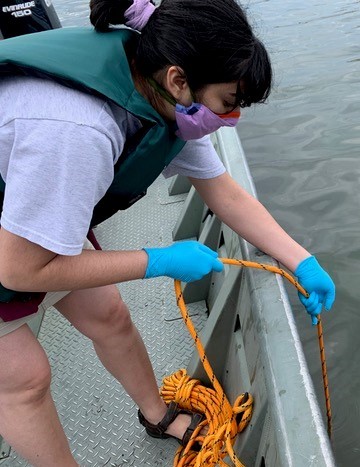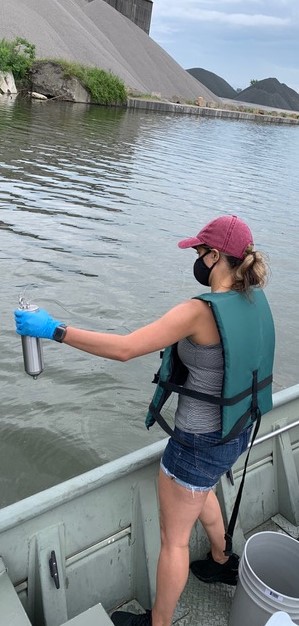Barber Fellows
This past summer, 2020, two Barber Fellows were focused on research right in the Detroit River. Dr Carol Miller, from Healthy Urban Waters, and Dr Tracie Baker of the Water Lab, at the Integrative Biosciences Center at WSU, submitted a proposal on PFAS research to the Barber Fellows program. The proposal was accepted and Supriya Gupta, a Public Health Major with Environmental Science Minor, and Aicha Khalaf , a Biology major, became part of the initiative to research PFAS contamination in the Detroit River. Even though social distancing was a concern, these researchers were able to experience working with a diverse team on a problem that is a growing concern for both humans and the environment. HUW caught up with them to find out more.


What was the problem you were researching and why is it important?
Per- and polyfluoroalkyl substances, or PFAS, are a family of man-made chemicals found in anything from popcorn bags to firefighting foam, and many common household products. PFAS consists of over 5,000 chemicals. Not much is known about these chemicals, and there is a paucity of policy that regulates the use and disposal of them. Now however, researchers and policymakers are becoming increasingly concerned about PFAS due to its tendency to accumulate in the environment, resistance to degradation, and its ability to bioaccumulate. Research shows that PFAS is linked to reproductive and developmental issues within humans. There has been growing alarm of PFAS levels in our drinking water, and with the Great Lakes serving as a drinking water source for many, it is an area of concern.
Many wastewater treatment plants are not designed to filter out PFAS chemicals, and there are several possible points within the Huron to Erie Corridor (HEC), the waterway that connects Lake Huron to Lake Erie that contribute to the accumulation within waterways. So Aicha and Supriya designed a map of possible contamination sources within (HEC), and headed out to start sampling (with social distancing in mind). They were helped by Robert Burns, Riverkeeper with Friends of the Detroit River, who volunteered his boat, and piloted it onto the Detroit River so the researchers could take sediment and water samples. The samples were then sent to a laboratory for PFAS chemical analysis.


"We can use the data from the chemical analysis of our samples to create a model of how PFAS moves in the Huron to Erie Corridor" says Aicha. A model is extremely helpful in tracking PFAS contamination in the HEC, and can also elucidate areas of high PFAS contamination levels that may pose a risk to human and ecological health. With all this information gathered, they used the HEC Spill Scenario Tool to create models. This tool uses the Huron to Erie connecting waterways to estimate travel times, over the course of a year. Tracer particles were released into the waterways to gather statistical information, which helped estimate travel times of PFAS within the corridor.
"We can also use this data to perform zebrafish trials, where we expose zebrafish to the exact combination and amount of PFAS contamination we found at our sample sites and see how it affects their growth and development" says Supriya. Zebrafish are an increasingly popular animal model, and because they share many of the same organ systems as humans, the effects of PFAS on zebrafish can be translated to human health as well. Zebrafish can also be used to approximate the impact PFAS may have on aquatic wildlife.
Any Next Steps?
Due to COVID-19, modelling and animal modelling were postponed, but moving forward the researchers hope to take the information from the analysis done through field sampling and apply it to their modelling. An additional next step is to conduct zebrafish trials where they can observe how the amounts and combinations of PFAS chemicals found at each sample site affects zebrafish growth, development, and reproduction. This will provide some insight as to how the PFAS chemicals in our waters may be affecting aquatic wildlife, and even how it affects humans.
How was the experience?
From Supriya: "It was amazing to see how knowledge from fields that I initially thought to be poles apart-engineering and environmental toxicology-could be combined to get a thorough understanding of PFAS in our water. I was able to see how a flow model created by an engineer could help inform decisions made by ecologists. The HEC spill modelling scenario that Aicha and I worked with taught me how models could also inform public health decisions-for example, to help authorities know when to close down public beaches due to dangerous contamination levels."
From Aicha: "It was amazing to work together with such an awesome team. Despite COVID-19, we were able to work around all the issues we faced, meeting every week on zoom, and still being able to do field sampling within the corridor. I was able to understand how different factors affect the fate and transport of contaminants within the waterways. As a Biology major, I've always found myself interested in the ecological aspect of things, so with this project working with both ecologists and engineers, I was able to understand much of the engineering side and the technical mapping that takes place behind the scenes."